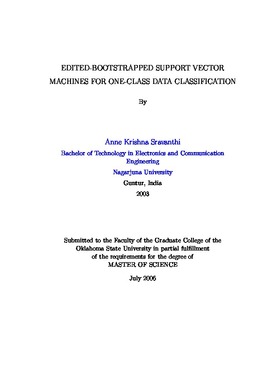| dc.contributor.author | Anne, Krishna Sravanthi | |
| dc.date.accessioned | 2014-04-17T20:09:17Z | |
| dc.date.available | 2014-04-17T20:09:17Z | |
| dc.date.issued | 2006-07-01 | |
| dc.identifier.uri | https://hdl.handle.net/11244/10278 | |
| dc.description.abstract | This research focuses on one-class remote sensing data classification problems. In general remote sensing data consists of samples that belong to different classes and are also highly overlapped in the feature space. Classification of such non-linear data becomes even more difficult if only one class is of interest. Therefore first and the foremost challenge lie in choosing a classifier. In this work, support vector machines (SVMs) are implemented as they are recently developed classifiers aiming at maximizing the margin between two clusters in a projected feature space. The SVM was mainly adapted to solve one-class problems, i.e., novelty detection. The one-class SVM (OCSVM) has a parameter ν to control the percentage of outliers or minority data. If outliers are present in the learning data set then classifiers tend to pick them as potential support vectors, which in turn degrade the classification performance. Different bootstrapping techniques were proposed in which pseudo replicate data sets were created by re-sampling to eliminate the affect of outliers during the training process. We have proposed an edited-bootstrapped SVM for one-class data classification. This is an iterative process in which OCSVM is used for data classification. The parameter ν is assigned to a small value as the percentage of outliers is unknown. In each iteration the detected outliers are removed from the training data set. The iterations stop when there are no more outliers to be detected from the training data set. This algorithm was used to address one-class remote sensing problems associated with the United States Department of Agriculture (USDA)'s Conservation Reserve Program (CRP). The CRP program seeks to convert highly erodible lands with active crop production to permanent vegetative cover. Specifically, there are two essential needs pertaining to CRP management and evaluation, i.e., CRP compliance monitoring and CRP mapping. Multi-spectral and multi-temporal Landsat TM imageries are used for the data classification. Compliance monitoring checks if the farmers are following the contract stipulations. CRP mapping produces up-to-date and accurate maps of CRP lands based on satellite imageries. In each CRP tract most of the area is assumed to be compliant. Our algorithm fails if most of the CRP tract is noncompliant. Multiple edited-bootstrapped OCSVMs are trained on different CRP cover types, and are applied for CRP classification individually. The complete CRP map is obtained by merging the different classifier outputs. The main advantage of the proposed algorithm is that both the CRP issues are combined into one flow. The simulation results proved that the proposed algorithm produces better classification results when compared with the existing bootstrapping techniques. | |
| dc.format | application/pdf | |
| dc.language | en_US | |
| dc.publisher | Oklahoma State University | |
| dc.rights | Copyright is held by the author who has granted the Oklahoma State University Library the non-exclusive right to share this material in its institutional repository. Contact Digital Library Services at lib-dls@okstate.edu or 405-744-9161 for the permission policy on the use, reproduction or distribution of this material. | |
| dc.title | Edited-bootstrapped Support Vector Machines for One-class Data Classification | |
| dc.type | text | |
| osu.filename | Sravanthi_okstate_0664M_1939.pdf | |
| osu.college | Engineering, Architecture, and Technology | |
| osu.accesstype | Open Access | |
| dc.description.department | School of Electrical & Computer Engineering | |
| dc.type.genre | Thesis | |
